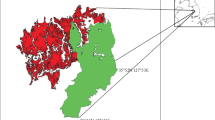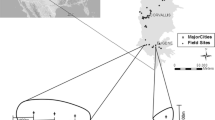Abstract
The mosaic of trees, shrubs and open grassland in mesic African savannas is highly dynamic and strongly influenced by mammal herbivory and fire. We investigated the bird fauna in four different savanna habitats to help assess the impacts of vegetation change on this component of faunal diversity. Birds were censused, plant species were identified and vegetation structure was measured in four different vegetation types (Acacia nilotica woodland, Acacia nigrescens woodland, broadleaf thicket and open grassland) in the Hluhluwe-Umfolozi Park in northern KwaZulu Natal, South Africa. Multivariate ordination analyses were used to determine the relative importance of vegetation structure and floristic composition in defining bird assemblages. The bird communities of the grasslands, the acacia woodlands, and the broadleaf woodlands were clearly separated on the first axis of the detrended canonical correspondence analysis (DCCA). Canopy cover and foliage height diversity (FHD) were strongly correlated with the first axis of DCCA, possibly reflecting a secondary successional series from grassland to woodland, known as bush encroachment. Floristic composition (based on presence–absence data only) seemed to be less important for bird community composition than vegetation structure. The results indicate that changes in vegetation structure, caused by bush encroachment, could cause concomitant changes in bird community composition.
Similar content being viewed by others
References
Archer S., Scifres C.J., Bassham C. and Maggio R. 1988. Autogenic succession in a subtropical savanna: rates, dynamics and processes in the conversion of grassland to thorn woodland. Ecological Monographs 58: 111–127.
Archer S., Coughenour M., Dall'Aglio C., Fernandez G.W., Hay J., Hoffman W. et al. 1995. Savanna biodiversity and ecosystem properties. In: Solbrig O.T., Medina E. and Silva J.F. (eds), Biodiversity and Savanna Ecosystem Processes: A Global Perspective. Ecological Studies, Vol. 121. Springer-Verlag, New York, pp. 207–215.
Ambuel B. and Temple S.A. 1983. Area dependent changes in the bird communities and vegetation of southern Wisconsin forests. Ecology 64: 1057–1068.
Balfour D.A. and Howsion O.E. 2002. Spatial and temporal variation in a mesic savanna fire regime: responses to variation in annual rainfall. African Journal of Range and Forage Science 19: 45–53.
Bibby C.J., Burgess N. and Hill D.A. 1992. Bird Census Techniques. Academic Press, London.
Herremans M. 1993. Effects of woodland modification by African elephant Loxodonta africana on bird diversity in northern Botswana. Ecography 18: 440–454.
Hoffman T.M. and O'Connor T.G. 1999.Vegetation change over 40 years in the Weenen/Muden area, KwaZulu-Natal: evidence from photo-panoramas. African Journal of Range and Forage Science 16: 71–88.
Loiselle B.A. and Blake G. 1994. Annual variation in birds and plants of a tropical second-growth woodland. The Condor 96: 368–380.
MacArthur R.H. and MacArthur J.W. 1961. On bird species diversity. Ecology 42: 594–598.
McCoy E.D. and Mushinsky H.R. 1994. Effects of fragmentation on the richness of vertebrates in the Florida scrub habitat. Ecology 75: 446–457.
Meyer B. 1999. Supervised LANDSAT-TM mapping of the spatially heterogeneous savanna of Hluhluwe-Umfolozi Park, KwaZulu-Natal (unpublished).
Pomeroy D. 1992. Counting Birds. African Wildlife Foundation, Nairobi, Kenya.
Pooley E. 1993. The Complete Guide to Trees of Natal, Zululand and Transkei. Natal Flora Publications Trust, Durban, South Africa.
Ralph C.J. 1985. Habitat association patterns of forest and steppe birds of northern Patagonia, Argentina. The Condor 87: 471–483.
Richards S.A., Possingham H.P. and Tizard J. 1999. Optimal fire management for maintaining community diversity. Ecological Applications 9: 880–892.
Schieck J., Lertzman K., Nyberg B. and Page R. 1995. Effects of patch size on birds in old growth montane forests. Conservation Biology 9: 1072–1084.
Skowno A.L., Midgley J.J., Bond W.J. and Balfour D.A. 1999. Secondary succession in Acacia nilotica (L.) savanna in the Hluhluwe Game Reserve, South Africa. Plant Ecology 145: 1–9.
Smith T.M. and Goodman P.S. 1987. Successional dynamics in an Acacia nilotica¶Euclea divinorum savannah in southern Africa. Journal of Ecology 75: 603–610.
ter Braak C.J.F. 1987. The analysis of vegetation¶environment relationships by canonical correspondence analysis. Vegetatio 69: 69–77.
ter Braak C.J.F. and Verdonschot P.F.M. 1995. Canonical correspondence analysis and related multivariate methods in aquatic ecology. Aquatic Sciences 57: 255–289.
Watson H.K. and Macdonald I.A.W. 1983.Vegetation changes in the Hluhluwe-Umfolozi Game Reserve Complex from 1937 to 1975. Bothalia 14: 265–269.
Whateley A. and Porter R.N. 1983. The woody vegetation communities of the Hluhluwe-Corridor-Umfolozi Game Reserve Complex. Bothalia 14: 745–758.
Whelan C. 2000. Foliage structure influences foraging of insectivorous forest birds: an experimental study. Ecology 82: 219–231.
Willson M.F. 1974. Avian community organization and habitat structure. Ecology 55: 1017–1029.
Willson M.F., De Santo T.L., Sabag C. and Armesto J.J. 1994. Avian communities of fragmented south-temperate rainforests in Chile. Conservation Biology 8: 508–520.
Rights and permissions
About this article
Cite this article
Skowno, A., Bond, W. Bird community composition in an actively managed savanna reserve, importance of vegetation structure and vegetation composition. Biodiversity and Conservation 12, 2279–2294 (2003). https://doi.org/10.1023/A:1024545531463
Issue Date:
DOI: https://doi.org/10.1023/A:1024545531463




